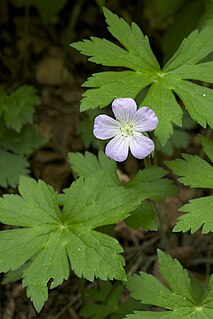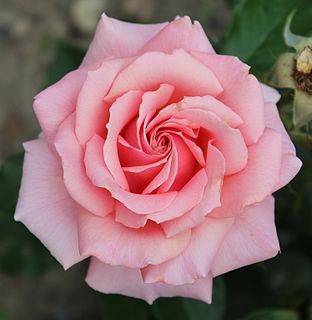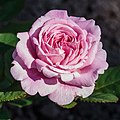
Rosa 'Anne Harkness' is an apricot floribunda rose cultivar developed by Jack Harkness in 1979 and introduced into Great Britain in 1980. The rose makes an outstanding cut flower and its exceptionally long lasting in water.

Dianthus barbatus, the sweet William, is a species of flowering plant in the family Caryophyllaceae, native to southern Europe and parts of Asia. It has become a popular ornamental garden plant. It is a herbaceous biennial or short-lived perennial plant growing to 13–92 cm tall, with flowers in a dense cluster of up to 30 at the top of the stems. Each flower is 2–3 cm diameter with five petals displaying serrated edges. Wild plants produce red flowers with a white base, but colours in cultivars range from white, pink, red, and purple to variegated patterns. The exact origin of its English common name is unknown but first appears in 1596 in botanist John Gerard's garden catalogue. The flowers are edible and may have medicinal properties. Sweet William attracts bees, birds, and butterflies.

Paeonia brownii is a low to medium height, herbaceous perennial flowering plant in the family Paeoniaceae. It has compound, steely-gray, somewhat fleshy leaves and small drooping maroon flowers. Its vernacular name is Brown's peony, native peony or western peony. It is native to the western United States and usually grows at altitude, often as undergrowth in part-shade. The fleshy roots store food to carry the plant through the dry summers and produce new leaves and flowers the following spring.

Geranium maculatum, the wild geranium, spotted geranium, or wood geranium, is a perennial plant native to woodland in eastern North America, from southern Manitoba and southwestern Quebec south to Alabama and Georgia and west to Oklahoma and South Dakota.

Rosa 'Général Jacqueminot', also called 'General Jack' or 'Jack Rose', is an early Hybrid Perpetual rose cultivar, developed by Roussel, an amateur from Meudon, and introduced by the gardener Rousselet in 1853. The flower was named in honor of Jean-François Jacqueminot (1787-1865), a French general of the Napoleonic Wars. Its parentage is unclear, but 'Gloire des Rosomanes' and 'Géant des Batailles' are considered probable ancestors.

Rosa 'La France' is a pink rose cultivar found in France in 1867 by the rosarian Jean-Baptiste André Guillot (1827–1893). It is generally accepted to be the first hybrid tea rose. Its introduction is therefore also considered the birth of the modern rose. As the cultivar was not systematically bred, its hybrid parentage can only be speculated, but 'Madame Falcot' is considered as a possible parent.

Rosa'KORbin' is a white floribunda rose cultivar bred by Kordes in Germany in 1958. It is also known as Iceberg, Fée des Neiges and Schneewittchen. 'KORbin' is among the world's best known roses.

Rosa'Double Delight',, is a multiple award winning, red blend hybrid tea rose cultivar bred in the United States by Swim & Ellis and introduced in 1977. Its parents were two hybrid tea cultivars, the red and yellow 'Granada' and the ivory 'Garden Party'.

Tulips (Tulipa) are a genus of spring-blooming perennial herbaceous bulbiferous geophytes. The flowers are usually large, showy and brightly colored, generally red, pink, yellow, or white. They often have a different colored blotch at the base of the tepals, internally. Because of a degree of variability within the populations, and a long history of cultivation, classification has been complex and controversial. The tulip is a member of the lily family, Liliaceae, along with 14 other genera, where it is most closely related to Amana, Erythronium and Gagea in the tribe Lilieae. There are about 75 species, and these are divided among four subgenera. The name "tulip" is thought to be derived from a Persian word for turban, which it may have been thought to resemble by those who discovered it. Tulips originally were found in a band stretching from Southern Europe to Central Asia, but since the seventeenth century have become widely naturalised and cultivated. In their natural state they are adapted to steppes and mountainous areas with temperate climates. Flowering in the spring, they become dormant in the summer once the flowers and leaves die back, emerging above ground as a shoot from the underground bulb in early spring.

Rosa 'Precious Platinum' is a medium red hybrid tea rose. It was bred by Patrick Dickson in Northern Ireland in 1974. The cultivar was introduced into Australia in 1977.

Rosa 'Sunsprite' is a rose variety developed by Reimer Kordes and introduced in 1973. The rose was derived from the cultivars 'Friedrich Wörlein' × 'Spanish Sun', and is one of the most successful floribunda roses. It was named 'Friesia' after the region Frisia (Friesland), the home of the breeder, and was one of the first roses to be given a code name.

Garden roses are predominantly hybrid roses that are grown as ornamental plants in private or public gardens. They are one of the most popular and widely cultivated groups of flowering plants, especially in temperate climates. An enormous number of garden cultivars have been produced, especially over the last two centuries, though roses have been known in the garden for millennia beforehand. While most garden roses are grown for their flowers, often in dedicated rose gardens, some are also valued for other reasons, such as having ornamental fruit, providing ground cover, or for hedging.

Rosa 'Nevada' is a white rose cultivar developed by Pedro Dot in Spain in 1927. It is one of his most successful creations and is named for its colour, as nevada is the Spanish word for "snowy". Its parentage was long under discussion, as Dot introduced the cultivar as a hybrid moyesii, but the cultivar's round, black hips point to its R. pimpinellifolia-parentage. It is probably a cross between Dot's pink hybrid tea 'La Giralda' and the wild rose species Rosa pimpinellifolia var. altaica, but is sometimes still described as a hybrid moyesii.

Rosa 'Elina' is a light yellow hybrid tea rose bred by Patrick Dickson of Northern Ireland in 1983. The variety was developed from the white floribunda 'Nana Mouskouri' and the apricot hybrid tea 'Lolita'.
Iris bicapitata is a plant species in the genus Iris, it is also in the subgenus Iris. It is a rhizomatous perennial, from the Gargano Peninsula, Italy. It has sickle or pointed leaves, shorter than the flowering stem. It has two flowers, which come in variable shades from yellow, white, lilac, blue and violet. They can also be bi-coloured. It is thought to have been derived from Iris pseudopumila. It is cultivated as an ornamental plant in temperate regions.

Graham Thomas is a deep yellow shrub rose bred by British rose breeder, David C.H. Austin, and introduced into the United Kingdom by David Austin Roses Limited (UK) in 1983. The cultivar was named for legendary rose horticulturalist, Graham Thomas. The rose was awarded the Royal Horticultural Society's Award of Garden Merit in 1993 and inducted into the Rose Hall of Fame in 2009 as "World's Favourite Rose".

Rosa 'Tournament of Roses',, is a grandiflora rose cultivar, bred by William Warriner, and introduced into the United States by Jackson & Perkins in 1988. The rose was named for the Tournament of Roses flower festival and parade held annually in Pasadena, California. The cultivar was named an All-America Rose Selections winner in 1989.

Rosa 'Queen Elizabeth' is a pink Grandiflora rose cultivar, bred by rose grower, Dr. Walter Lammerts in the United States in 1954. The rose variety is very popular worldwide and has won numerous awards, including "World's Favorite Rose", (1979).

Rosa 'Soleil d'Or' is a Foetida hybrid rose cultivar, bred by Joseph Pernet-Ducher and introduced on November 1, 1900. It is the ancestor of all modern Hybrid tea roses and the first yellow-orange rose. Pernet-Ducher later crossed 'Soleil d'Or' with Tea roses to create a new class known as Pernetiana roses.

Rosa 'Charlotte Armstrong' is a pink Hybrid tea rose cultivar developed by Dr. Walter Lammerts and introduced in the U.S. by Armstrong Roses in 1940. The rose won the All-America Rose Selections Award (AARS) and the Portland Gold Medal in 1941.




















